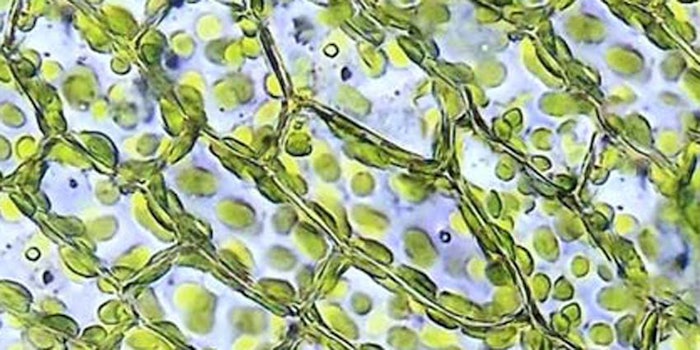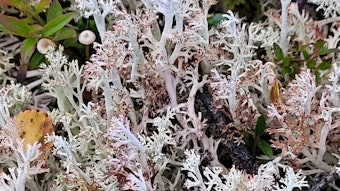
Inspired by the meditative practice of forest bathing, Mibelle Biochemistry AG has tapped into the ancient water-retaining capabilities of Aloina aloides (aloe moss) to cultivate a sustainable skin care ingredient demonstrating novel activity: harmonizing skin’s moisture flow.
The ingredient, MossCellTec Aloe (INCI: Xylitol (and) Caprylyl Glycol (and) Ketoglutaric Acid (and) Water (Aqua)) was launched during the company’s 30-year Cyber Celebration, held on June 17, 2021.
See related: Mibelle Biochemistry's MossCellTec No. 1
Forest Bathing and Moss Muse
Sharing the inspiration for MossCellTec Aloe was Beata Hurst, head of sales for Mibelle Biochemistry AG in South Africa, Canada and German-speaking regions. “MossCellTec is a contemporary ingredient that fits with the current trend for forest bathing,” she said, explaining that by 2050, two-thirds of the population will live in cities, placing a heavier emphasis on reconnecting with nature. “Spending time in nature is a growing need, and this trend reflects that.”
Hurst described forest bathing as more than a walk in the woods. “It is taking in, with all your senses, the forest atmosphere. It is … a conscious and contemplative mindset—a mobile meditation.” She added is it a type of therapy in regions including Japan, where the practice was coined as Shinrin-yoku by the Japanese Ministry of Agriculture, Forestry and Fisheries. This practice also fits alongside the current market drivers for health, well-being and well-aging.
See related: I'm Outside Launches Forest Bathing in a Bottle
The woods and nature led to moss as a source for the MossCellTec Aloe ingredient. “Mosses were among the first plants to grow on dry land some 470 million years ago,” Hurst explained. “Mosses absorb water directly from the air into their leaves. They can absorb up to 30x [their weight in water],” she added, highlighting this water regulation function, tolerance for dry conditions and fast rehydration response once water becomes available.
Based on the protonema formed during the early stages of Aloina aloides (aloe moss) development, a culture extract was derived for the reproducible, sustainable and scalable production of this resource. The approach utilized requires only a small quantity of plant, no land is needed and no wastewater is produced. The material is cultivated in sterile bags that, once full, are harvested, filtered, cold-pressed and extracted again to form a concentrate. “The method uses little amounts of plant material,” said Hurst. “And the ingredient is not dependent on seasons. It also produces the same quality [of ingredient], completely free of pollutants and pesticides.”
Mechanism of Action: ‘Harmonizing’ Skin Moisture
Following Hurst, Franziska Wandrey, Ph.D., head of research for Mibelle Biochemistry explained the ingredient’s mechanism of action. She started with some biology basics. “Connexins are proteins that form a ring of six in the membrane of a cell [such as keratinocytes], and when two cell membranes come together and both of them have a connexin ring, they form a gap junction that is basically a channel that allows the transport of materials between those two cells.” She added that this channel is important for water exchange as well as signaling molecules and ions to flow between cells to synchronize their response to the environment.
As cells age, they communicate less effectively through these gap junctions. This is where MossCellTec Aloe steps in: to improve cellular communication through the gap junctions. This is reflected by an even distribution of skin moisture, reduced wrinkles and increased skin elasticity. The company developed a novel in vitro assay to test these effects, in brief by culturing keratinocytes and adding adenosine triphosphate (ATP) to initiate signaling between cells. Fluorescent labeling was then used to visualize calcium released from cellular stores as they signaled or moved from one cell to the next through gap junctions.
These calcium “waves” can be measured in terms of speed and intensity, as well as in the presence or absence of the moss active. In vitro, calcium was shown to spread a given distance in 8 sec without treatment. With the MossCellTec Aloe ingredient, the same distance was traversed in 1 sec. Furthermore, cells were treated with glyoxal to artificially age them and in the presence of the active, the signaling intensity was significantly improved.
Next, in vivo, 43 subjects with signs of aging such as crow’s feet wrinkles were treated with a 2% MossCellTec Aloe cream or a placebo twice daily for 28 days. Parameters measured included elasticity, wrinkle volume/depth, skin hydration and hydration homogeneity—across 53 points on the face. Combined hydration mapping across subjects in each test group revealed a 14% improvement in hydration evenness after just 14 days and 20% improvement after 28 days. General skin hydration also was improved.
Hurst concluded the ingredient clearly demonstrates efficacy for moisturizing and balancing formulas, as well as holistic well-being concepts, healthy aging and spa/wellness formulas. She added, “It [also] is based on fascinating story of moss and clever water management.” Finally, he highlighted the new claim for “harmonizing the moisture flow in skin,” based on convincing efficacy, as well as the ingredient’s 100% natural and sustainable status, meeting the global well-being and healthy aging trends.










